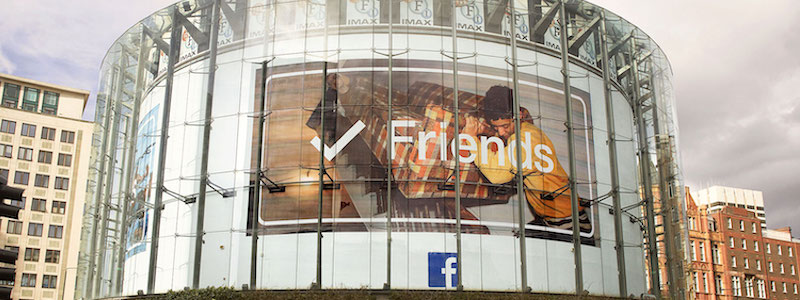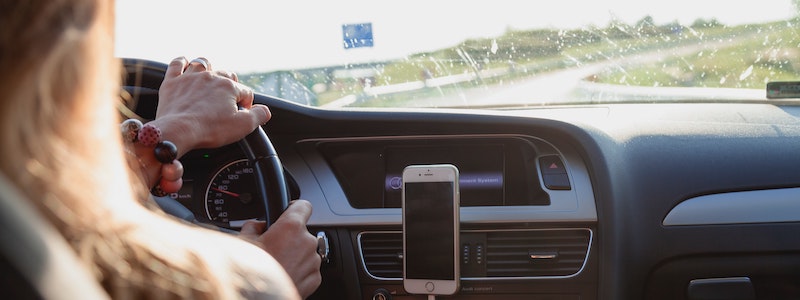Have you ever seen a billboard ad for Facebook and stopped to wonder why one of the top online advertising powers in the world invests its marketing dollars into outdoor advertising?
Maybe not, but oh the irony. We personally think it’s pretty powerful that Facebook – an online marketing tool that stresses using its advertising tools to promote business – spends it’s own marketing dollars on a traditional form of marketing in billboards.
Live What You Love Campaign
One of the more noticeable Facebook billboard campaigns took place early last year across India. The campaign, entitled “Live What You Love” pushed groups, pages and events to Indian users in an effort to encourage them to join groups to find like-minded people.
The ads aired on prime time tv, and across prominent billboards in Mumbai, New Delhi, and several other cities.

Spam Is Not Your Friends Campaign
Perhaps the better-known example of Facebook using TV, print ads and large billboards is the most recent campaign that began in March of last year around America. The sparse billboards and bus stop signs proclaimed “Spam is not your friends”, “false news is not your friends” and “clickbait is not your friends” along with a promise to change the way things appear in the newsfeed.
This campaign was in response to bombshell revelations about how Russian bots used Facebook to disseminate false information, spam, and clickbait to influence the 2016 presidential election.
Facebook then went on to launch a summer campaign in the European Union to advise users of their rights under the General Data Protection Regulation Act.

Traditional Advertising is Still Key
Facebook’s efforts to reach its users not only on its own platform, but through traditional advertising methods like TV commercials, print ads and outdoor advertising on billboards, bus stops, subway signs and more underscore that the more things change, the more they stay the same.
In fact, outdoor advertising and billboards are the only advertising industry that is seeing more forecasted growth. In 2018, outdoor marketing was expected to grow 2% to account for an $8 billion market.
On the other hand, other traditional advertising saw a decline last year:
- National TV Advertising: -1.5%
- Local TV Advertising: -3.5%
- Newspaper Advertising: -19%
- Magazines -15%
- Radio: -4%
The fact that outdoor advertising is the only section of the market seeing profitability amongst a mix of other traditional advertising methods shows us that outdoor media, billboards and signage are still one of the most effective ways to reach consumers when not on a digital platform.
Digital is the Difference
However, there is a marked difference between the success of traditional billboards and of digital billboards. Digital options are proven to be more cost-effective, and the bright, eye-catching effects that allow for multiple ads to appear on a single billboard makes the display more profitable for agencies and billboard owners.
Industries are taking notice of this, too.
Across a span of 10 years (2013 forecasted to 2023) spending on traditional billboards remains flat at $6 billion total. However, digital billboard advertising climbs year over year. From $646 million spend in 2013, the market is expected to hit $2 billion in 2023.

Billboards of the Future
In the world of digital advertising and smartphones, some of the biggest streaming and service providers spend a huge amount of their marketing budget on strategic outdoor displays. In fact, even the iPhone has poured marketing funds and innovation into billboard strategy, with its iPhone X selfie campaign. Netflix also invests in billboards everywhere.
The Outdoor Advertising Association of America estimates that for every dollar spent on an outdoor advertising ad, it delivers $5.97 in return on investment. With new developments in location data and tracking, this is only forecasted to grow.
That’s because billboards are being fitted with tech and sensors to recognize when a person is nearby, or even analyze their smartphone data to specifically target passerby with curated content. Technology integration is revealing new advertising avenues every day, including computers analyzing data and statistics to decide when and where to place digital ads for the best impact.
In addition, new surfaces for advertising are being explored, including stationary car and taxi windows, as well as interactive and targeted directories, bus stop signs, retail windows and more. The outdoor advertising industry shows no signs of slowing, and the future of the digital billboard is bright!



 787 792 4113
787 792 4113

Leave a Reply
Want to join the discussion?Feel free to contribute!